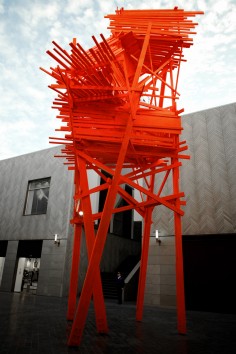Arne Quinze
АРНЕ КУИНЗ
The Visitor, Beirut
source: highlike
Work: ‘The Visitor’ is a 16-meter-high Stilt House, hidden in the midst of the renewed Souk buildings in the centre of Beirut. This large Stilt House has the same features as its smaller editions. (The artist makes smaller sculptures and paintings in which Stilt Houses are incorporated.) Stilt Houses have the appearance of fragile, vulnerable people, who keep on standing and surviving in every context, despite their thin legs. They are proof of man’s incredible flexibility.
During the construction of the ‘The Visitor’, Arne Quinze was influenced by the reflection of the bright sunlight on the buildings, built in white natural stone. As a result of this reflexion, in the evening, the Stilt House radiates a warm orange glow, which attracts people from near and far to this part of the town to discover where this glow comes from. You have to be prepared to get lost in the narrow streets of the Souk to discover this stranger in the city. Once they have got in touch with this strange visitor, Arne Quinze hopes that people will be stimulated to continue with an open mind and rediscover the city, starting from a whole new perspective. This is what his patrons, Solidere, also wanted to achieve. A renewed Beirut, which leaves its past behind and moves towards the future with an open mind: a modern city in the Middle East.
Photographer: Dave Bruel
Formal name of the project: The Visitor, Public – wooden art installation
Location of the project: Souks district, Beirut, Lebanon
Client: Solidere, Beirut
Construction periode: June1-June17, 2009
Lifespan: 2009-2014
Dimensions: 5mL*5mL*16mH
Materials: 8.000m Douglas pine, orange fluo color, Flame Save fireproof & eco-insecticide treatment.
Photographer: Dave Bruel
.
.
.
.
.
.
.
source: rojoprojects
Arne Quinze was born in 1971 in Belgium and lives and works in Sint-Martens-Latem, Belgium. In the eighties he began working as a graffiti artist but he never finished an official art education. Quinze creates large and small sculptures, drawings, paintings, and large-scale installations. Smaller works, sketches, and drawings are the basis and research for his large installations. Recurring fundamentals in his oeuvre are the use of multiple types of wood, including salvaged wood; electrical colors in fluorescent paint; and themes referring to social interaction, communication, and urbanism. Since a while he’s doing research towards large steel installations.
What drives Quinze is the belief in the possible realization of an idealistic society where all individuals communicate and interact, aiming to bring people together and push them into a vigorous dialogue. In his urban vision, communal activities flourish and social cohesion is the norm. His installations are built to provoke reaction and to intervene in the daily life of passersby confronted with his sculptures. His unconventional public installations have challenged perceptions in the city centers of Belgium (Cityscape, The Sequence), Germany (The Traveller), France (Camille, Rock Strangers), Lebanon (The Visitor), China (Red Beacon) and the USA (Uchronia, Timegate), among others.
At first sight this monumental wooden structure seems a visual chaos with mixed orange, black and natural colored wooden slats. Yet at a closer look one will notice all wooden planks are put on a specific place having a precise function. When looking at the sculpture people should see how these elements are in balance. Seemingly constantly seeking for an equilibrium the structure never loses its balance. It’s almost like you can see the installation moving.
Although he realizes communal activities are diminishing, his installations are built to represent a symbolic and physical connection between people and to provoke reaction. He aims to intervene in the daily life of passersby confronted with these eye-catching sculptures. By using his trademark orange colour and monumental dimensions the artist instigates astonishment and literally lures the people into the space. These aspects rise questions and fascination. Often he compares his installations with the effect of what we feel when seeing a great force of nature. Confrontation with unspoilt nature blows you away and leaves you completely dazed. In the city confrontation of this proportion is lacking. This semi-public installation will have that function in an urban context.
In every culture Quinze comes across, he unravels physical processes, drawing inspiration for his oeuvre, and is fueled by overwhelming optimism. Every new creative breed captures his research and study on interaction, and urban movement expressing the continuously evolution of human beings and their surroundings. Besides building architectural sculptures, he creates complex art pieces and video installations inscribing his vision in society of how people see themselves and society. Works as Bidonvilles, Stilthouses, Chaos and My Home My House My Stilthouse, My Secret Garden have been shown on several exhibitions.
.
.
.
.
.
.
.
source: miramar-hotels
Бельгийский художник Арне Квинз известен как автор крупномасштабных инсталляций для городских пространств. Его работы провоцируют прохожих и зрителей, оказывают эмоциональное воздействие, вместе с этим вплетаются в городскую ткань и мирно соседствуют с окружающей средой. Арне Квинз создает большие и малые скульптуры, рисунки, картины. Его малые произведения являются основой для исследования более крупных и важных процессов. В его творчестве присутствуют повторяющиеся мотивы, например использование нескольких видов древесины, электрооборудование, цвета флуоресцентной краски (желтый, оранжевый и черный), а также темы социального взаимодействия, общения, ритма и взаимодействия линий.
.
.
.
.
.
.
.
source: tacco15
Arne Quinze è nato e vive e lavora in Belgio. Ha iniziato con i graffiti ma ha proseguito il suo cammino artistico come scultore e pittore, doti che utilizza per creare le sue vere opere, enormi installazioni. “Così l’uomo diventa piccolo e inizia a chiedersi qual è il suo ruolo sul pianeta”. Un modo di conoscere se stesso confrontandosi con gli altri e cercando di capire come ogni persona vive la propria vita in maniera diversa.


